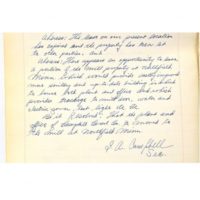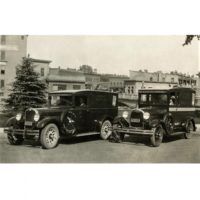
By Stephanie Hess, Northfield-Rice County Digital History Collection, January 2019
In 1919, John S. Campbell created the Campbell Cereal Company. This company made only one product: a hot cereal mix of wheat farina and malted barley called Malt-O-Meal. Campbell invented Malt-O-Meal because he thought regular hot wheat cereal had no flavor, and it took too long to prepare.
The Campbell Cereal Company opened its first plant in Campbell’s hometown of Owatonna, Minnesota. He blended, toasted, packed, and sold the first orders by himself. Then the Campbell Cereal Company moved into Northfield’s Ames Mill in 1927. Malt-O-Meal cereal has been made there ever since.
John Campbell first sold Malt-O-Meal to stores and brokers in Minnesota and Iowa. To increase sales, he began to advertise it to a larger market. Starting in the 1930s, the Campbell Cereal Co. sponsored radio programs to reach a wider audience. The company also started offering free prizes in exchange for cereal box tops and proofs of purchase. Later, they printed Malt-O-Meal advertisements in magazines. They also made popular television commercials.
The Campbell Cereal Company became the Malt-O-Meal Company in 1953. It introduced Chocolate Malt-O-Meal in 1961. Chocolate Malt-O-Meal was the company’s first successful new product since 1919.
The Malt-O-Meal Company started making cold ready-to-eat cereals in 1965. Its first flavors were Puffed Wheat and Puffed Rice. The company purchased the Northfield Creamery building to make these new cereals. The company named this building the Campbell Mill to honor its founder, John S. Campbell.
In the decades to follow, the Malt-O-Meal Company introduced many new cereal flavors. For example, Toasty O’s came in 1975, followed by Sugar Puffs in 1980 and Tootie Fruities in 1989. The company packed these cereals in plastic bags and sold them as a lower-priced alternative to the boxed cereals of their competitors.
In the 1990s, the company developed more cereals to attract children. Some of the well-known flavors from this period are Marshmallow Mateys and Frosted Mini Spooners. They also started making corporate brand cereals for grocery chains.
To handle these products, the company expanded both the Campbell Mill and the distribution center in Northfield. They also opened new plants in Utah and North Carolina. In recent years the company added organic and natural cereal lines and became MOM Brands.
In 2015, the Post Holdings cereal company purchased MOM Brands. Malt-O-Meal and the other MOM Brands cereals became part of Post Consumer Brands. These products are still made in Northfield today.
Primary Sources
Discussion Questions
When you look at the individual items in the Northfield-Rice County Digital History Collection, use the zoom-in tool to view details in the images or more easily read the documents. Use the tab labeled “TEXT” to read full transcriptions of the documents.
Questions
- Take a closer look at these meeting minutes. Why did the Campbell Cereal Company decide to move to Northfield? What made the Ames Mill an ideal place for a cereal factory?
- Looking at the photographs and documents, what can you say about the relationship between this company and the city of Northfield and its people over the years? How did the company and Northfield help each other?
- Compare and contrast the way cereal is delivered by taking a look at this photograph of Malt-O-Meal delivery trucks, this railroad line, and this distribution center.
- Why did Northfield’s Stuart Motel (now the Archer House) advertise Malt-O-Meal in its official stationery?
- In 1936, the company headquarters moved to Minneapolis, but the manufacturing plant remained in Northfield. Why did they do that?
- This 1954 Northfield Independent article provides more details and photographs of how hot Malt-O-Meal was made at the time. Describe the different innovations used by John Campbell and later company employees to develop the cereal and automate the manufacturing process.
- When the Campbell Cereal Company moved to Northfield in 1927, they only had 20 employees. By 2015, the company employed 1,550 people – 651 in Northfield itself. Why do you think the company grew so large? How did that affect [something important]?
- After selling only one product for so many years, the Malt-O-Meal Company finally began adding new food products to their production lineup in the 1960s. This is called “product diversification”. Why do you think the company wanted to diversify? How did this change the company?
- Check out the 75th Anniversary photo album from 1994. How and why did Malt-O-Meal celebrate this special milestone?
- Before its sale in 2015, MOM Brands was one of the major private employers in Northfield. Would you want to work there? Why or why not? What would you do?
Beyond the Classroom
- Do you know anyone who has worked or currently works for the Malt-O-Meal Company or Post Consumer Brands? If so, come up with a list of questions to ask them about their jobs, their backgrounds, what they did for Malt-O-Meal, who they worked with, etc. This is called an “oral history.” Ask them for permission to record and/or take notes during the interview. Report back to the class what you have learned. These guidelines from UCLA can give you some ideas to start.
Related Items on the Northfield-Rice County Digital History Collection
Additional Resources
Hughlett, Mike. “Post buys Lakeville-based MOM Brands for $1.15 billion.” Minneapolis: Star Tribune, February 3, 2015. Web (accessed May 17, 2018).
Jeffrey, Kirk. “Bread and butter.” In Continuum: threads in the community fabric of Northfield, Minnesota, sponsored by the Northfield Bicentennial Committee. Pages 40-61. Northfield, MN: The City of Northfield, 1976.
Malt-O-Meal Collection, Accession Number 2016.20. Northfield Historical Society, Northfield, Minn. Finding Aid (published 2018) and some collection materials available online (accessed May 17, 2018).
Our Story: A Guide to the History of Northfield Minnesota. Northfield, MN: Northfield Historical Society Press, 2013.
Pontius, Leo. [untitled transcript of taped interview on Malt-O-Meal History by the Executive V.P.]. c. 1985. In the Malt-O-Meal Collection at Northfield Historical Society.
Willems, Janice. “Malt-O-Meal Chronology.” Minneapolis: Malt-O-Meal Company, 2004. In the Malt-O-Meal Collection at Northfield Historical Society.
Zellie, Carole. “Historic Resources.” In Northfield: The History and Architecture of a Community, produced by Northfield Heritage Preservation Commission. Pages 44-86. Northfield, MN: Northfield Printing, 1999.
Primary Source Analysis
Here are some tips for analyzing the primary sources found above and throughout the DHC. For each source, ask students to indicate:
- the author’s point of view
- the author’s purpose
- historical context
- audience
For inquiry-based learning, ask students to:
- explain how a source tells its story and/or makes its argument
- explain the relationships between sources
- compare and contrast sources in terms of point of view and method
- support conclusions and interpretations with evidence
- identify questions for further investigation
Additional Tools
- Document Analysis Worksheets from the National Archives
- Teaching with Primary Sources Videos and Sets from the Minnesota Historical Society
- Using Primary Sources from the Library of Congress
Minnesota Education Standards
Here is a list of education standard codes for benchmarks that can be explored using this Primary Source Set.
- 0.4.1.2.1
- 1.4.1.2.1, 1.4.2.4.2
- 2.4.1.2.1
- 3.4.1.2.1
- 5.4.1.2.1
- 6.4.1.2.1, 6.4.4.20.1
- 7.4.1.2.1, 7.4.4.20.1
- 9.4.1.2.1
- 1.8.7.7
- 2.8.7.7
- 3.2.7.7, 3.6.2.2, 3.6.7.7, 3.6.8.8, 3.8.2.2, 3.8.7.7, 3.8.8.8
- 4.2.7.7, 4.6.2.2, 4.6.7.7, 4.6.8.8, 4.8.2.2, 4.8.7.7, 4.8.8.8
- 5.2.7.7, 5.6.2.2, 5.6.7.7, 5.6.8.8, 5.8.2.2, 5.8.7.7, 5.8.8.8
- 6.12.1.1, 6.12.2.2, 6.12.4.4, 6.12.7.7, 6.12.9.9, 6.14.2.2, 6.14.7.7, 6.14.8.8
- 9.12.1.1, 9.12.2.2, 9.12.4.4, 9.12.7.7, 9.12.9.9, 9.14.2.2, 9.14.7.7, 9.14.8.8
- 11.12.1.1, 11.12.2.2, 11.12.4.4, 11.12.7.7, 11.12.9.9, 11.14.2.2, 11.14.7.7, 11.14.8.8
Send us feedback about this primary source set.
This publication was made possible in part by the people of Minnesota through a grant funded by an appropriation to the Minnesota Historical Society from the Minnesota Arts and Cultural Heritage Fund. Any views, findings, opinions, conclusions or recommendations expressed in this publication are those of the authors and do not necessarily represent those of the State of Minnesota, the Minnesota Historical Society, or the Minnesota Historic Resources Advisory Committee.


















